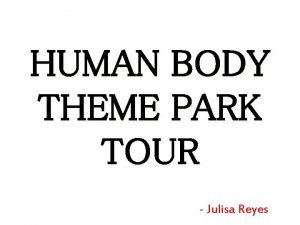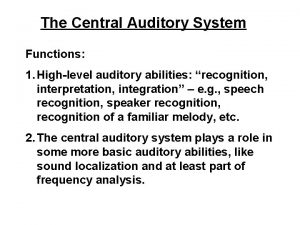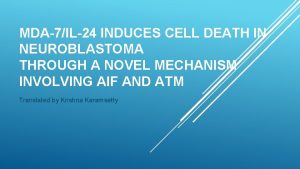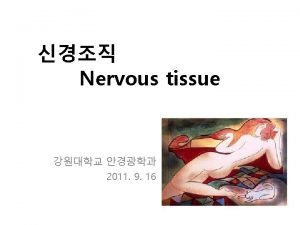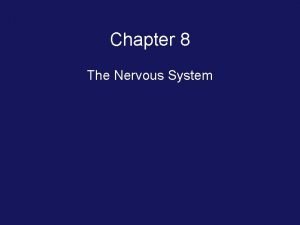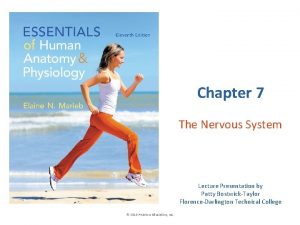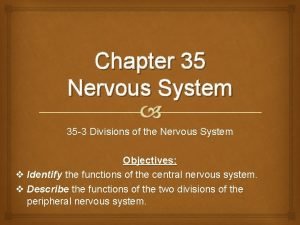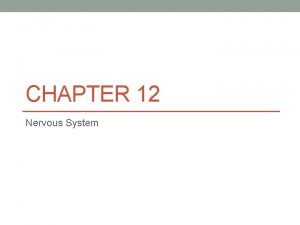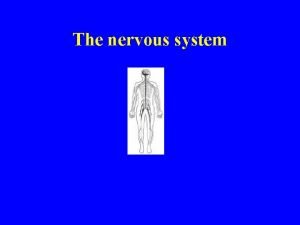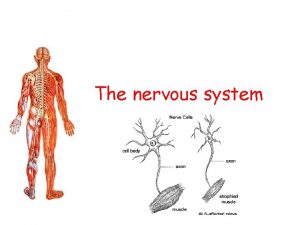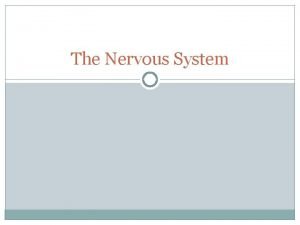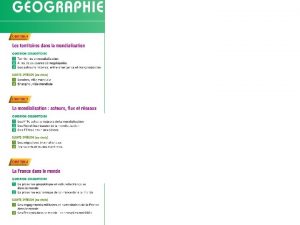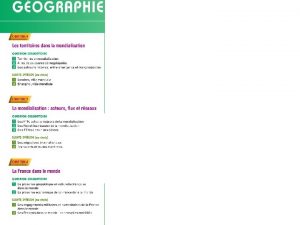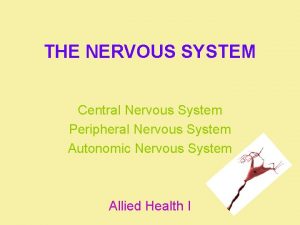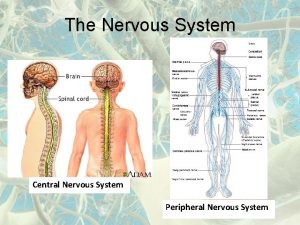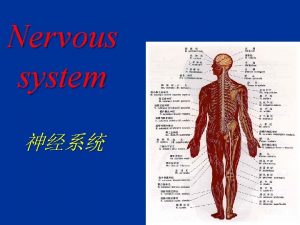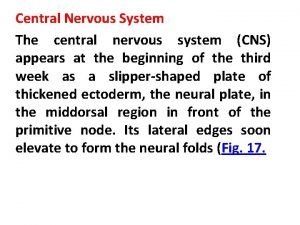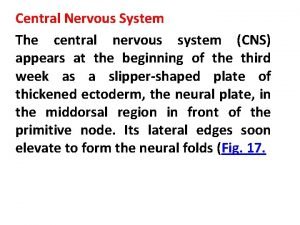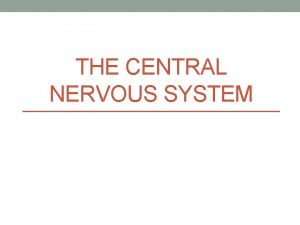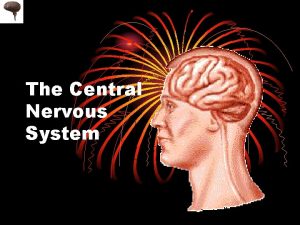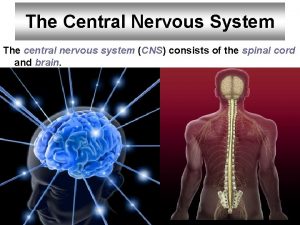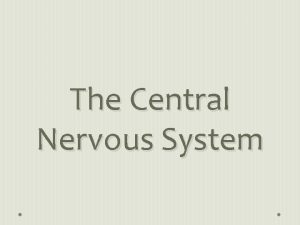Central Nervous System Chapter 8 Page 144 The



































- Slides: 35

Central Nervous System Chapter 8

Page 144 The Nervous System v There are two communication systems in the body: • The endocrine system & the nervous system ü They send chemical & nerve impulses throughout the body ü Hormonal communication is slow whereas neural regulation is comparatively rapid.

Page 144 Divisions of the Nervous System v Nervous • Central nervous system ü • System is divided into two The brain & spinal cord Peripheral nervous system ü 12 pairs of cranial nerves & 31 pairs of spinal nerves Ø Autonomic nervous system ² the sympathetic & parasympathetic systems

Page 144 Central Nervous System (CNS) v Most highly organized system of the body. Functions of the CNS include: 1. 2. Communication & coordination in the body • Receives messages from stimuli all over the body (The brain interprets the messages) • The brain responds to the messages & carries out activities Seat of intellect & reasoning

Page 144 v Called The Nerve Cell the neuron • Transmits messages from one cell to another v In addition to nucleus, cytoplasm, & cell membrane this cell has extensions of cytoplasm from the cell body called: • Dendrites (can have several) carry impulses toward the cell body • Axons (only one per cell) carry impulses away from the cell body ü Myelin sheath – Specialized covering on the axon

Page 145 Figure 8 – 1

Page 145 Nervous Tissue v Neuroglia (glial cell) – insulate, support, & protect the neurons. • Astrocytes – transport nutrients to neurons & restrict what substances can enter the brain, form the blood-brain barrier • Microglia – Remove cellular debris • Oligodendrocytes – CNS structures that wrap around neuronal axons, forming the myelin sheath • Schwann cells – PNS structures that wrap some neuronal axon to form the myelin sheath

Pages 144 – 145 Nervous Tissue (Cont’d) v Neurons • Motor (efferent) neurons carry messages from the brain & spinal cord to the muscles & glands • Associative (interneurons) neurons carry impulses from the sensory neurons to the motor neurons (in CNS system) • Sensory (afferent) neurons receive stimuli from receptor sites in the sensory organs (skin, ears, nose, & taste buds) & carry messages or impulses toward the spinal cord & brain.

Pages 145 – 147 Function of the Nerve Cell/Membrane Excitability v Membrane excitability = the process of nerves carrying impulses by creating electric charges

Pages 147 – 148 Synapse v v v Where messages go from one cell to the next cell Synaptic cleft = The space between the axon of one nerve cell & the dendrites of another Neurotransmitters = Chemical substances that make it possible for messages to cross the synapse to a target receptor

Page 148 SB Effects of Aging v Slowing v Loss nerve conduction of brain size v Slowing of reaction time v Changes in sleep patterns v Important to continue physical & mental activity to stimulate nerve cells, blood flow & neurotrophin production

Pages 148 – 149 v Weighs The Brain about 3 pounds (1, 400 grams) v Protected by Meninges & cerebrospinal fluid v Without oxygen, brain damage occurs within 4– 8 minutes v Made up of 100 billion neurons & is divided into • Cerebrum • Diencephalon • Cerebellum • Brain stem

Page 149 Figure 8 – 5

Page 149 v Storage Memory of old & new information v Role of the hippocampus of the limbic system is to decide the significances of the event & determining where in the brain the information should be stored v Short- or long-term memory

Page 149 Coverings of the Brain v Dura mater – Outer that lines the inside of the skull v Arachnoid mater – Middle layer, resembles a fine cobweb v Pia mater – Inner layer, covers the brain, consists of blood vessels (called the choroid plexus) & connective tissue v Cerebrospinal fluid – Acts as a shock absorber & a source of nutrients

Page 150 Ventricles of the Brain v Cerebral ventricles = Four lined cavities filled with cerebrospinal fluid • 1 st & 2 nd largest & are know as the right & left lateral ventricles • 3 rd is connected to the two lateral ventricles via the interventricular foramen • The 3 rd & 4 th are connected via a narrow canal called the cerebral aqueduct v Choroid plexus helps with the production of cerebral spinal fluid

Pages 150 – 151 Cerebrospinal Fluid (CSF) v Formed inside the four ventricles v Transports nutrients to & removes metabolic waste products from the brain cells v Blood-brain barrier – choroid plexus capillaries are selectively permeable v Lumbar puncture – removal of cerebrospinal fluid for diagnostic purposes

Pages 151 – 152 v Largest Cerebrum part of the brain – Weighs about 2 pounds v Cerebral cortex (gray matter) – covering the upper & lower surface of the cerebrum v Fissures v Gyri sulci (deeper) & sulci (shallow) (convolutions) = elevated ridges between the

Page 152 Five Major Fissures v Longitudinal v Transverse fissure v Central fissure v Lateral fissure v Parieto-occipital fissure

Page 152 Figure 8 – 8

Page 152 – 153 Cerebral Functions v Frontal lobe – forms the anterior portion of each hemisphere. v Parietal lobe – Located behind the frontal lobe. v Occipital lobe – Located over the cerebellum. v Temporal lobe – Located beneath the frontal & parietal lobes. v Limbic lobe or system – located at the center of the brain beneath the other four lobes; encircles the top of the brain stem.

Page 153 Figure 8 – 9 (A)

Page 153 Figure 8 – 9 (B)

Pages 154 – 155 Diencephalon v Located between the cerebrum & the midbrain. It contains two structures: • Thalamus – a spherical mass of gray mater found deep inside each of the cerebral hemispheres, lateral to the 3 rd ventricle. ü Relay station for incoming & outgoing nerve impulses. Damage to the thalamus may result in increased sensitivity to pain or total loss of consciousness. • Hypothalamus – lies below the thalamus. ü Part of the limbic system & considered to be the “brain” of the brain

Page 155 Hypothalamus 1. 2. 3. 4. 5. 6. 7. 8. 9. 10. Autonomic nervous control Cardiovascular control Temperature control Appetite control Water balance Manufacture of oxytocin Gastrointestinal control Emotional state Sleep control Mind-over-body experiences

Page 156 v Located Cerebellum behind the pons and below the cerebrum v Right & left cerebellar hemispheres connected by vermis v Gray matter on the outside and white matter on the inside v Communicates with the rest of the CNS by three pairs of tracts called peduncles

Page 156 Cerebellar Function v Maintenance of balance – if the body is imbalanced, sensory receptors in the inner ear send nerve messages to the cerebellum. There the cerebellum carries impulses to the motorcontrolling areas of the brain. These brain areas, in turn, stimulate muscles contraction, which move the body to restore balance. v Maintenance of muscle tone v Coordination of muscle movements – any voluntary movement is initiated in the cerebral cortex. However, once the movement is started, its smooth execution is the role of the cerebellum.

Page 156 v Provides Brain Stem a pathway for ascending & descending tracts v Made up of three parts: v Midbrain – extends from the mammillary bodies to the pons. v Pons – bridge located in front of the cerebellum, between the midbrain & medulla oblongata. v Medulla oblongata – a bulb-shaped structure found between the pons and the spinal cord.

Pages 156 – 157 Spinal Cord v v v Begins at foramen magnum of the occipital bone & ends at the second lumbar vertebrae 31 pairs of spinal nerves Protected by meninges & other tissues White (outside) & gray matter (inside) Functions • Carry messages from the sensory neurons to the brain for interpretation, then carry the response back through the motor neurons to muscles & glands • serve as the reflex center for the body

Page 157 Disorders Meningitis – inflammation of the linings of the brain & spinal cord. v Encephalitis – inflammation of the brain. v Epilepsy – a seizure disorder of the brain, characterized by a recurring & excessive discharge from neurons. v Cerebral palsy – a disturbance in voluntary muscular action due to brain damage. v Poliomyelitis – a contagious viral disease of the nerve pathways of the spinal cord that causes paralysis. v

Pages 157 – 158 Disorders (Cont’d) Hydrocephalus – a condition that involves an increased volume of cerebrospinal fluid within the ventricles of the brain due to a blockage. v Parkinson’s disease – characterized by tremors, a shuffling gait, pill-rolling (movement of the thumb & index finger), & muscular rigidity. v Essential tremor – a disorder that causes rhythmic shaking. v Multiple sclerosis – an autoimmune, chronic inflammatory disease of the CNS in which the immune cells attack the myelin sheath of nerve cell axons. v

Pages 158 – 159 Disorders (Cont’d) v West Nile virus (WNV) – mosquito-borne virus. v Dementia – a general term that includes specific disorders such as Alzheimer’s disease. v Alzheimer’s disease – a progressive degenerative disease in which the initial symptom is usually a problem with remembering recently learned information. v Tumors – may develop in any area of the brain.

Pages 159 – 160 Brain Injuries v Hematoma – localized mass of blood collection. They may occur in the spaces between the meninges. v Concussion – the result of a severe blow to the head. It may be mild or severe & there may be temporary loss of consciousness. v Coup & contrecoup injury – describe head injuries. v Coup = occur within skull near the point of impact v Contrecoup = one that occurs beneath the skull opposite to the area of impact.

Pages 160 – 161 Spinal Cord Injuries v Quadriplegia – injuries between C 1 – C 4 v C 5 – C 7 leads to varying degrees of paralysis of the arms & shoulders v Paraplegia – injuries at T 1 – T 12 & L 1 – L 5 v Leads to loss of bladder, bowel, & sexual function are common

Page 159 SB v Tension Headaches – usually a dull, squeezing pain that builds slowly & may involve the forehead, scalp, back of the neck, and both sides of the head. v Migraine – throbbing pains occurs on one side of the head & gradually spreads. Can be accompanied by nausea & vomiting. They may last for hours or even days. v Cluster – pain is worse than migraine pain. Can occur one or more times a day for weeks.
 Neuronal pools
Neuronal pools Fundamentals of the nervous system and nervous tissue
Fundamentals of the nervous system and nervous tissue What are neuron processes
What are neuron processes Major division
Major division Central nervous system amusement park
Central nervous system amusement park Cns
Cns Nervous tissue
Nervous tissue Hydras
Hydras Central auditory nervous system
Central auditory nervous system Electrical synapse vs chemical synapse
Electrical synapse vs chemical synapse Central nervous system for kids
Central nervous system for kids Signing naturally page 144
Signing naturally page 144 Nervous system and digestive system
Nervous system and digestive system Endocrine system vs nervous system
Endocrine system vs nervous system Mechanism of action of hormones
Mechanism of action of hormones Adh function
Adh function Central nervous sysytem
Central nervous sysytem Chapter 7 the nervous system
Chapter 7 the nervous system Chapter 15 nervous system diseases and disorders
Chapter 15 nervous system diseases and disorders Chapter 8 the nervous system
Chapter 8 the nervous system Chapter 7 the nervous system figure 7-2
Chapter 7 the nervous system figure 7-2 Chapter 35 nervous system
Chapter 35 nervous system Chapter 14 lesson 3 the nervous system
Chapter 14 lesson 3 the nervous system Chapter 12 nervous system
Chapter 12 nervous system Apa.format title page
Apa.format title page Chemical messengers of the nervous system
Chemical messengers of the nervous system Nematoda
Nematoda The nervous system is made up of
The nervous system is made up of What are the three basic functions of the nervous system
What are the three basic functions of the nervous system Nervous system learning objectives
Nervous system learning objectives Stimulus in nervous system
Stimulus in nervous system Objectives of nervous system
Objectives of nervous system Autonomic nervous system visceral
Autonomic nervous system visceral Sympathetic nervous system def
Sympathetic nervous system def Plexuses
Plexuses Sns somatic nervous system
Sns somatic nervous system




